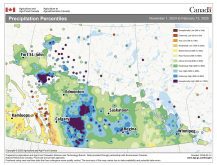Manitoba producers expected to plant less because of bad weather; Alberta and Saskatchewan could also drop slightly
After several years of growth, corn acres will likely be flat or down in Western Canada this year.
In Manitoba, which has the majority of grain corn acres, seeding has been delayed by cold weather in early May.
“Generally … most of our acres are usually planted in the first and second week (of May),” said Morgan Cott, Manitoba Corn Growers Association agronomist.
That’s not the case this year because temperatures have been well below normal this spring. For several nights in early May the temperature dipped below freezing.
Read Also

StatCan stands by its model-based crop forecast
Statistics Canada’s model-based production estimates are under scrutiny, but agency says it is confident in the results.
“As for grain corn, In Manitoba I don’t think there’s going to be any increase (in acres) at all,” Cott said May 13.
“I think we’re going to have a decrease because guys are getting a bit concerned about planting corn right now.”
Statistics Canada, in an estimate of field crop acres, pegged Manitoba grain corn acres at 437,300, down slightly from 459,000 in 2019. That number and all Statistics Canada estimates come with an asterisk this year because the department conducted its acreage intention survey in March.
Statistics Canada cut the survey short because of the COVID-19 pandemic to reduce the burden on farmers, so the number of responses was smaller than normal.
Nonetheless, corn acres should be flat or down in 2020 because 2019 wasn’t a great year for the crop.
Manitoba growers struggled to harvest corn last fall, thanks to incessant rains in September and 25 to 50 centimetres of snow in early October. Most of the grain corn in the province was combined in November or during the winter.
A sizable chunk was harvested in March, when fields were still frozen, Cott said.
Those difficult conditions have dragged into May.
Corn that was seeded in early May could be in jeopardy because of the freezing temperatures.
“The corn that would have been in the ground isn’t doing anything. If it had germinated or absorbed any moisture, it’s going to be injured,” Cott said.
“(But) I think that planting has been delayed, (so) the majority of our acres (will) miss that.”
In Alberta, Statistics Canada predicted a small bump in grain corn acres from 29,000 last year to 35,000 in 2020.
However, silage corn could take a hit.
Statistics Canada says acres will be 141,000, down from 261,000 in 2019.
A number of Alberta growers are turning away from silage corn because of a dry summer and below average yields in 2019.
“It was a tough year for corn last year and some feedlot producers may need silage earlier than the corn will come off, so they put a few more acres into cereals,” said Nicole Rasmussen, an agronomist with Corteva in Lethbridge. “Corn doesn’t come off until September or October (and) they might need inventory before then.”
Silage corn has been gaining traction in Saskatchewan, going from 50,000 acres in 2016 to more than 100,000 in 2019. That trend may flatten out or pull back in 2020 because Statistics Canada has estimated silage corn acres at 92,000.
In Manitoba, Cott doesn’t have a sense of silage acres. They have steadily risen since 2017 and hit 130,000 last year, based on Statistics Canada data.
One of the challenges for grain corn is that it should be seeded by the middle of May.
But many Manitoba farmers have been dealing with leftover crop from 2019 and applying fertilizer, so getting corn in the ground at the optimal time hasn’t been easy.
“Corn growers have been concerned about planting into cool soils but were also worried about calendar date given the season requirements of the crop,” Manitoba Agriculture said in its mid-May crop report.
“Agronomists report that discussions with clients about appropriate soil temperatures for seeding have been much more common this year.”
If growers failed to get corn in the ground over the May long weekend, some may opt for other crops this spring.
“If they can’t get planting in the next week (May 14-21), then they might give up some of those corn acres,” Cott said. “The guys that grow corn … know how to manage their spring, even when they’re being pushed, but there’s just a lot to do this spring.”
It is possible to seed corn in late May if there’s an open fall, but last year was a reminder that a wet and cold autumn is a real risk.


















